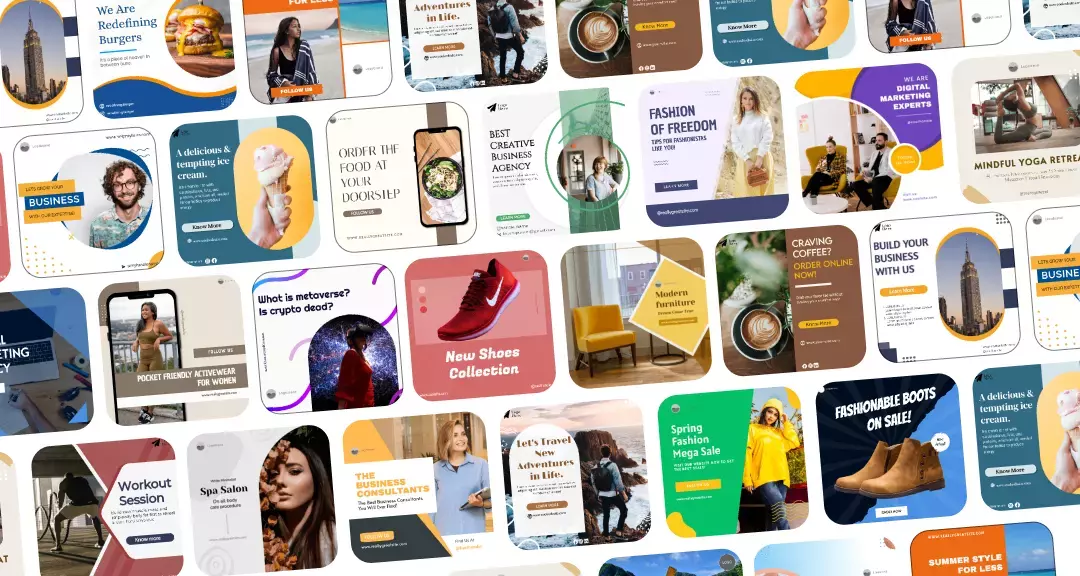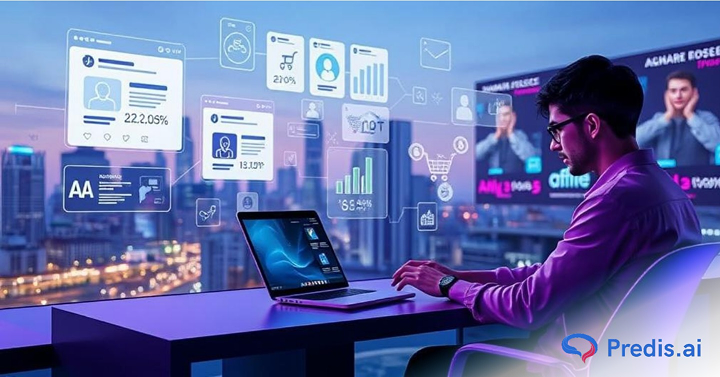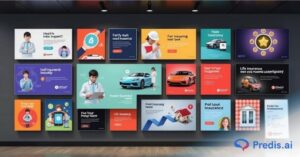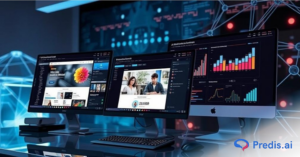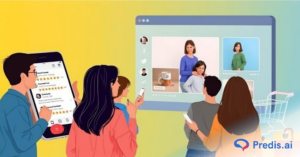Think about starting a campaign with someone who knows your community better than you do. It sends the right word at the right time and even changes itself as it goes along. That is not science fiction; it’s how powerful artificial intelligence (AI) can be in marketing and ads. No longer is AI a trendy word. Businesses are changing how they reach people, handle budgets, and measure success because of this useful tool. in this guide, we’ll talk about how AI is transforming marketing and advertising, why it’s important, and how you can start using it to grow your brand.
Why AI Matters in Advertising & Marketing?
Marketers have always had one goal: to reach the right people at the right time. The issue? Guesswork and inefficiency are part of traditional methods. Artificial intelligence development services help eliminate that.
- AI gives marketers the potential to target very specific groups instead of broad ones since it can quickly find trends in huge datasets.
- Automate the jobs that are repetitive.
- Get the most return on investment (ROI) from your ad spend.
- Give each customer a really unique experience.
In sum, AI helps you make better judgments, saves time, and cuts down on waste.
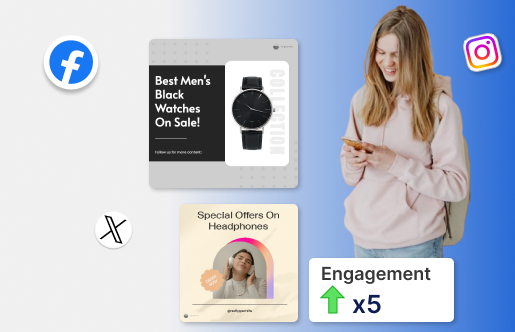
How AI is changing the field in important ways?
Smarter targeting and better use of budgets
AI finds the best audience by looking at things like demographics, online behavior, and past purchases.
- Adjustment in real time: Budgets change automatically based on how well a campaign does.
- Smarter segmentation: AI finds small groups that match your ideal customer profile with strong purpose, rather than broad age groups or locations.
- Better ROI: Less trash means more money goes to ads that really work.
Dynamic Content Creation
People want customization, and with the power of data science and AI, it’s easier than ever to deliver exactly what they want.
- Personalized ad copy: Headlines, calls to action, and email subject lines can be changed to fit the needs of different groups of people.
- Automated visuals: Ad creatives are made by platforms like Predis AI, Adobe Sensei based on what the audience likes.
- Scalability: It doesn’t take weeks for marketers to start hundreds of different personalized ads.
Customer Segmentation and Predictive Analytics
Why wait for outcomes when you can guess what they will be?
- Behavior prediction: AI can guess when a customer is most likely to buy something.
- Product suggestions: Amazon and other sites employ prediction models to sell more of the same product or a different one.
- Segmentation: Customers are categorized by how likely they are to buy, not just their demographics. This makes targeting smarter and based on data.
Optimizing for Voice Search and Natural Language
With the rise of Alexa, Siri, and Google Assistant, voice search has grown more common.
- Keywords for conversation: AI can tell the difference between real questions and short keywords.
- Local intent: Voice search often gives “near me” results, which are great for advertising in your area.
- Ad adaptation: Campaigns that are easy to say out loud make brands easier to find in hands-free searches.
Bidding in real time and using computers
AI makes ads that run on computers better.
- Split-second decisions: AI looks at data about the population and bids on ad locations immediately away.
- More efficient: You don’t have to estimate when you acquire media anymore.
- Competitive advantage: Real-time bidding gives marketers an edge over their competition because it allows them to find the appropriate person at the right time.
How people feel and how they respond to sentiment analysis?
AI doesn’t simply look at clicks; it also looks at how people feel.
- Social listening: This is when you look at how people talk about a business on different sites.
- Emotion detection: It can discern if words are neutral, good, or bad.
- Proactive responses: that is quick changes in messaging which helps brands to avoid PR difficulties or take advantage of new trends.
What to Keep an Eye On? Pros and Cons
Pros
- Efficiency: Automating jobs that are done over and over again saves time that can be used for strategy and creativity.
- Savings on costs: Better budgeting cuts down on useless ad spend.
- Personalization: Gives everyone a unique experience on a large scale.
- Insightful analytics: gives you deep, useful info that you can use to make better decisions.
Cons
- Technical difficulty: Setting up AI tools, teaching them, and sometimes integrating them with other systems are all things that need to be done.
- Data dependency: When you give AI data, it can only do as well as the data you give it. Bad or missing info can make things less effective.
- Privacy concerns: Customers are wary of how brands use their data because they care about their privacy. Because of stricter rules, marketers need to be very careful. Leveraging security automation alongside AI tools can help ensure AI compliance, protect customer information, and reduce risks tied to data misuse.
- Human oversight: Even though AI is very smart, it still needs creative and moral direction from people to avoid campaigns that aren’t sensitive to different viewpoints or are biased.
How to Start Using AI in Your Marketing Plan?
Get Your Data Ready: AI is only as good as the data it has to work with.
- Bring together sources: Use blogs, CRM, and social media to get information.
- Be sure of accuracy: Get rid of records that are copies, wrong, or out of date.
- Keep your privacy: Keep customer information safe and follow data rules.
Pick Out the Right Tools
Not every AI tool works with every brand
- AI copywriters: Ad copy can be written with the help of tools like ChatGPT, Jasper, and similar tools.
- Design AI: Tools, such as Predis AI, Adobe Sensei, make it easy to create customized images.
- Analytics AI: Google Analytics 4, HubSpot AI, and IBM Watson are all tools that can help you make guesses and divide your data into groups.
- Advertising AI: Placements can be done automatically with Google Ads Smart Bidding or Meta’s Advantage+.
Test, Learn, and Iterate: AI loves to try new things.
- Start out small: Before going big, run pilot ads.
- Compare the results: Compare ads that are run by AI to ads that are run by humans.
To sum up, use data to keep making performance better.
Watch for performance and figure out ROI
To sum up, use data to keep making performance better.
- Monitor KPIs: such as ROI, cost per acquisition (CPA), conversions, and click-through rates (CTRs).
- Set up dashboards: AI platforms often give reports in real time so that choices can be made more quickly.
- Always getting better: AI systems can learn from the results of your efforts and make them smarter over time.
AI trends that will shape the future of advertising
Artificial intelligence is only getting started. Here is what lies ahead in the road ahead:
- Advertisements will appear to have been specifically tailored for millions of users thanks to hyper-personalization at scale.
- Augmented and virtual reality (AR and VR) driven by artificial intelligence will allow buyers to “try before they buy.”
- Ethical AI standards, where there will be a greater emphasis placed on fairness, data privacy, and transparency.
- Ads may interact with linked devices such as smart TVs or automobiles through the integration of the Internet of Things.
As these AI trends continue to develop, brands that are able to adapt early will have an advantage over their competitors.

Conclusion
AI is no longer a choice; it’s a must. AI gives businesses an edge in the digital world by letting them do things like smarter targeting, dynamic content, predictive analytics, and tracking of how people feel about something. Start small, pick the right tools, and be willing to fail and learn from your mistakes. AI doesn’t replace imagination when it’s used correctly; it boosts it.
Are you ready for AI to change the way you sell and advertise? This is the future; now you just need to take the first step.
FAQs
AI helps with finding the right crowd, making the best use of budgets, making ads, doing predictive analytics, and bidding in real time. It helps brands get their word to the right people at the right time.
The biggest benefits are saving time and money, making things more personal, and getting insights that can be used. AI makes things easier to do by hand and helps make ads smarter and more data-driven.
Not at all. Not as a replacement, but as a tool that helps marketing. It does boring jobs and analyzes data, while people come up with new ideas, make plans, and use their emotional intelligence.
The biggest risks are using bad data, worrying about privacy, and the fact that computers might be biased. Without human monitoring, campaigns might stop being real or relevant.
